Understanding the structure of K-pop music is crucial for anyone aspiring to make a memorable cover song or original song for that matter.
This genre heralded from South Korea, has taken the globe by storm with its infectious tunes and unique melodies.
At the heart of this powerful music lie chord progressions, a secret ingredient that brings out the essence of the track.
This blog post aims to explain and demonstrate some of the common chord progressions found in your favorite K-pop songs.
With a practical approach, we will break down this complex subject into digestible insights.
Table of Contents
K-pop Chord Progressions
I-V-vi-IV (1-5-6-4)
An emotionally moving, quintessentially K-Pop chord progression for unforgettable covers.
This chord progression is a well-loved sequence in K-Pop music that generates an appealing blend of positive and melancholic tones, often used to invoke strong emotional responses. Despite its simplicity in structure, I-V-vi-IV allows for a wide array of melodies to overlay over it, creating versatility and making it a fundamental ingredient for unforgettable K-Pop tunes.
- Difficulty: Easy
- Example: G – D – Em – C (Key of G major)
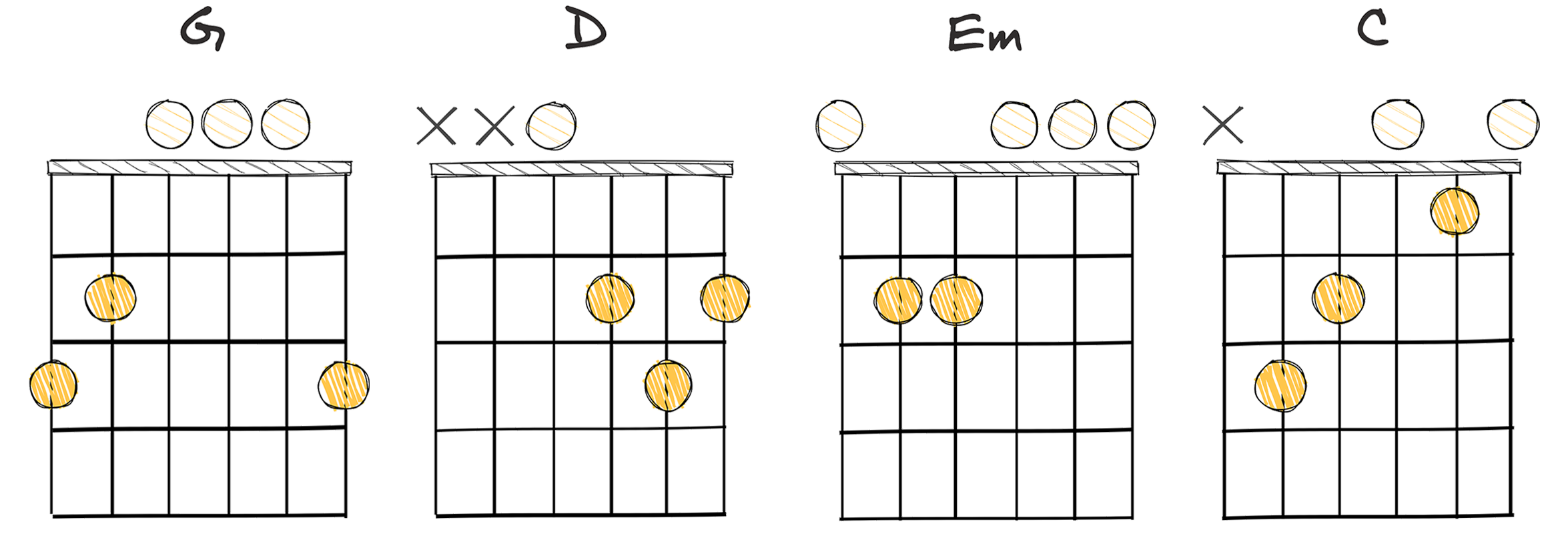
Chord progressions popular in K-Pop are cherished for their uniquely meaningful and catchy melodies that capture the hearts of fans worldwide.
One such progression is the I-V-vi-IV (1-5-6-4) progression, a cornerstone in many K-Pop genres that is not only memorable but also easy to play.
It’s simplicity and versatility, combined with the expressive emotion it can convey, contribute to its frequent use in the K-Pop scene.
The history of this progression shows that it dates back to the origins of pop music itself.
It remains relevant and popular as it has a proven ability to form the backbone of many unforgettable K-Pop cover songs.
This progression creates an amazing canvas to paint on for K-Pop artists, thanks to its contrasty yet harmonious elements.
The I-V-vi-IV progression, whilst steeped in musical history, is far from outdated.
Its ongoing usage and popularity in the K-Pop world attest to this progression’s enduring appeal and musical prowess.
Numerous iconic K-Pop hits have this chord progression at their core, making it a valuable tool in any aspiring K-Pop artist’s arsenal.
Bearing in mind the potential of the I-V-vi-IV progression can tremendously assist in creating your next unforgettable K-Pop cover song.
ii-V-I (2-5-1)
Explore the popular ii-V-I progression, a K-pop staple for catchy tunes.
The ii-V-I chord progression, also known as the 2-5-1 progression, is a key harmonic pattern in K-pop used to create a variety of moods and emotional resonance. It mostly commences from the second note of the diatonic scale, followed by the fifth, and ends on the first note, providing a sense of completeness and resolution to the music.
- Difficulty: Intermediate
- Example: Dm – G – C (Key of C major)
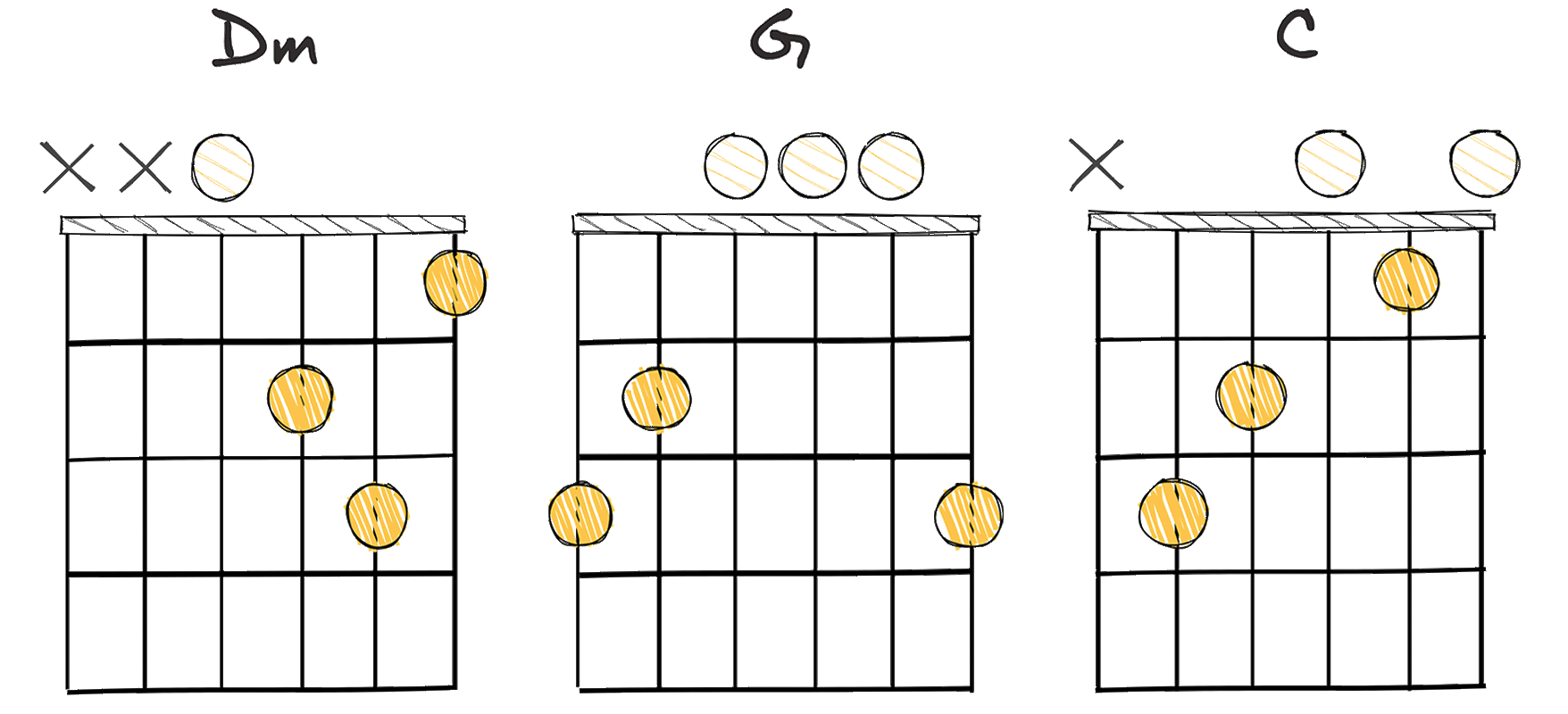
Understanding the intricate mechanics of K-Pop music, particularly its chord progressions, can help artists elevate their performances and create more engaging cover songs.
One chord progression frequently used in K-Pop that warrants discussion is ii-V-I (2-5-1) progression.
This particular sequence is deeply ingrained in various genres of music, not just K-pop, and can be considered a backbone in the world of harmony.
It’s perceived as an intermediate progression, which signifies that while it may require a bit of practice to master, it’s not overly intricate or perplexing.
The ii-V-I progression owes its popularity to its satisfying sense of resolution, with the ‘I’ acting as the home chord to which the sequence inevitably returns.
This synopsis provides an insight into why this progression is used so extensively.
The listener is taken on a crucial musical journey, beginning with the tension of the ‘ii’ and ‘V’ chords, which eventually resolves beautifully onto the ‘I’ chord.
It’s this ebb and flow of tension and resolution that makes this progression so magnetic.
Furthermore, the ii-V-I progression holds a significant spot in the history of chord progressions.
It has a long-standing reputation for being a choice progression in blues and jazz genres before it found its way into pop, and eventually into K-pop, demonstrating its versatility and universal appeal.
The ii-V-I chord progression can be played in the key of C major with the following chords: Dm – G – C.
The power of a chord progression isn’t solely in the chords being used, but also in the way it is executed.
Things like the rhythm, the voicing, and the inversions of the chords all come into play, adding layers to the sound.
The ii-V-I progression may seem simplistic on paper, but it carries immense potential for being used in innovative ways.
A diverse range of harmonies can be created by using new rhythms, varying the voicing of the chords or their sequence.
Mere imitation of the chords as they are might not yield the desired results.
It’s crucial for an artist to experiment and ingrain elements of their unique style within these progressions, for the most impactful outcomes.
That being said, the beauty of K-pop—and music in general—lies in its limitless possibilities.
Chord progressions like the ii-V-I serve as fundamental building blocks, but it’s up to the individual artists to transform these structures into a distinctive sound.
As we delve deeper into other conventional K-pop chord progressions, perhaps you will see how they each hold a distinct character and musical appeal of their own—something that can be effectively employed to add depth and variety to your covers.
Whether you’re a novice artist dipping your toes into the vast ocean of K-pop music, or a seasoned musician keen on exploration, understanding and mastering these chord progressions is a definite step towards creating more compelling and unforgettable K-pop performances.
vi-IV-I-V (6-4-1-5)
This progression brings a melancholic twist to the vibrant K-pop genre.
The vi-IV-I-V progression delivers a captivating and emotional ride, often used in K-Pop to create unforgettable melodies. This pattern offers an enchanting balance of resolving tension, creating an ethereal and sentimental musical landscape that is characteristic of many popular K-Pop hits.
- Difficulty: Intermediate
- Example: Am – F – C – G (Key of C major)
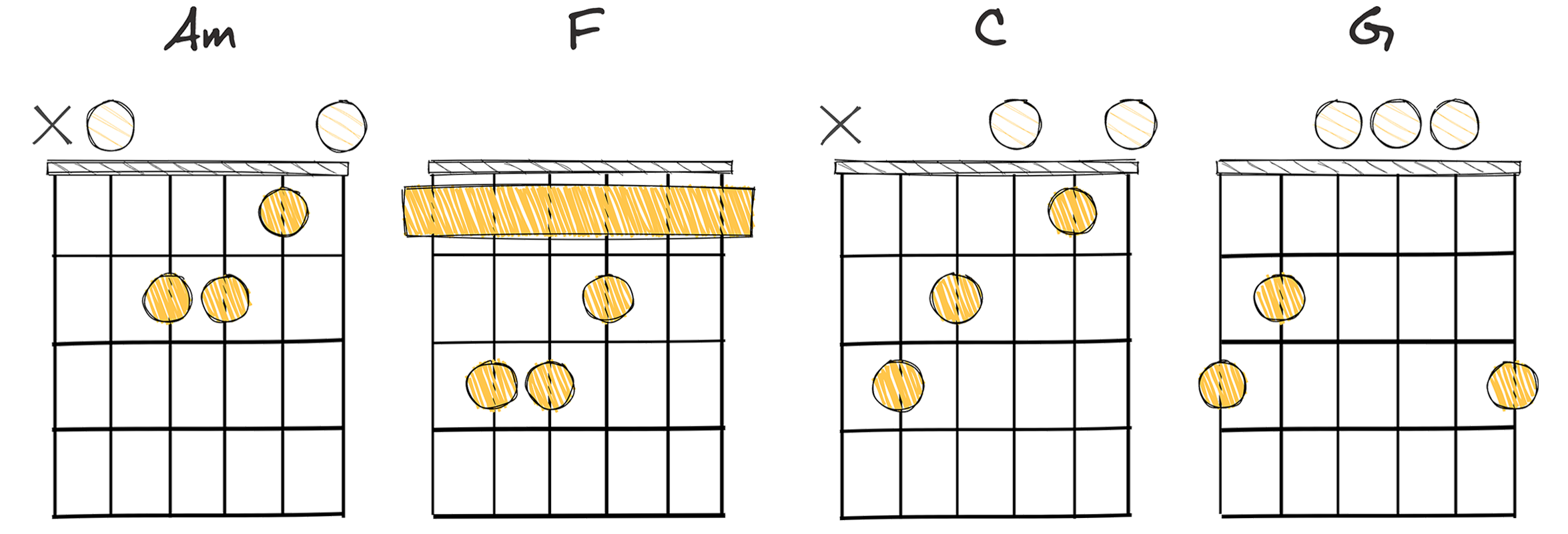
In the epic collection of K-pop chord progressions, the vi-IV-I-V (6-4-1-5) sequence holds a unique place.
This progression is adored by a good number of K-pop composers and music producers because of its momentous tonal transitions which produce a cascade of emotional expressions within the brief span of four chords.
This chord progression finds its roots in western pop music, but has found its way into K-pop due to its compelling tonality.
The intermediate level of complexity in executing this progression tends to attract those with an earnest desire to explore expressive depths of K-pop melodies.
Given its narrative nature, the vi-IV-I-V progression allows musicians to tell a cohesive and engaging musical story within a short sequence of chords
This sequence has the ability to seamlessly weave together the emotional highs and lows of a song, creating a deeply immersive and engaging listening experience for the audience.
Moreover, its balanced blend of uniqueness, familiarity, challenge, and manageability makes it a favorite of both starting musicians and seasoned K-pop writers alike.
Although this progression is more commonly executed in keys more comfortable for guitarists, such as G, D, A, and E major, it can certainly be played in the key of C major instead.
The chord order would then be Am – F – C – G.
It also provides a certain level of complexity without becoming too overwhelming for intermediate players.
Remember, it’s all about using these progressions effectively in ways that support your song’s unique character and message.
I-IV-vi-V (1-4-6-5)
A dreamy, nostalgic progression popular in K-Pop ballads and anthems.
This chord progression, I-IV-vi-V, is commonly found in many K-pop songs and helps to create a catchy and bright musical atmosphere. It starts with the primary chord, moves to the subdominant, transitions to the relative minor, and finally comes back to the dominant chord, building a great foundation for a memorable cover song in the K-pop genre.
- Difficulty: Easy
- Example: G – C – Em – D (Key of G major)
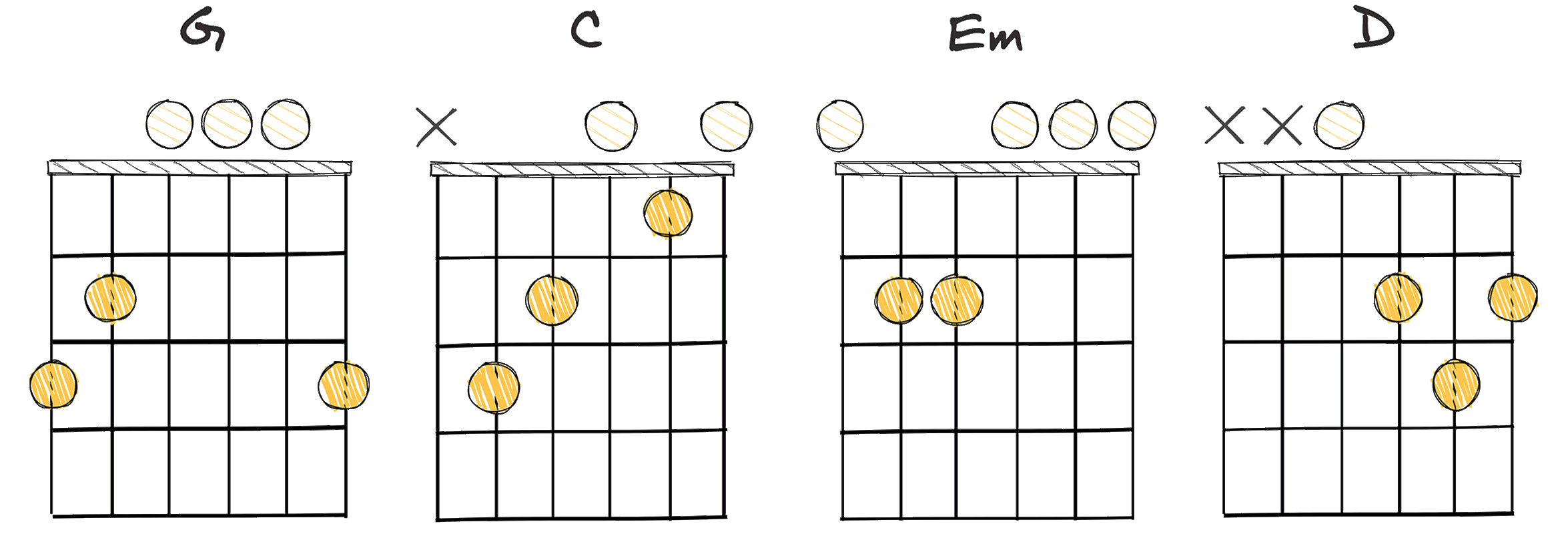
Our fourth section delves into the I-IV-vi-V (1-4-6-5) chord progression.
This chord progression, as with many others, isn’t unique to K-Pop.
Its usages spreads across various genres, including pop, rock, and country.
But for the sake of our discussion today, we will focus on K-Pop applications.
In order to fully understand the use of the I-IV-vi-V progression, it’s essential to understand the context of this progression in music history.
While it is of a modern origin, its development can be traced back to centuries ago.
Its roots lie in the baroque and classical period when composers started experimenting with more complex harmonies.
The rationale behind this arrangement of chords is the emotional path it carves.
With a strong start on the tonic (I), it moves up to the fourth (IV) which projects a sense of stability.
Following, the sixth (vi) chord brings about a notable shift, introducing a minor chord that invokes a sense of longing or sadness.
Wrapping up the progression, we return back to a major chord, the fifth (V), which inspires a sense of resolution and confidence.
Essentially, the progression promotes a sense of journey and resolution which is appealing to our emotional sensibilities.
Pretty as it may sound, this progression is also rather easy to play.
This makes it a favorable choice for budding musicians and covers, as it allows them to focus more on the vocal delivery.
Strikingly, the equivalent chords in the key of G Major, G – C – Em – D, also emulate the same progression.
Overall, the I-IV-vi-V chord progression creates a pleasant harmonic journey that listeners can ride along with.
Moreover, its straightforward structure allows musicians to experiment and focus on their delivery
Its universal appeal and ease of use have helped it stand the test of time, allowing it to transition seamlessly from classical eras right into the world of K-Pop.
Even though inherently simple, the I-IV-vi-V progression shouldn’t be underestimated, for it is versatile and impactful, as seen in K-Pop’s extensive repertoire.
vii°-V-vi-ii (7-5-6-2)
This progression delivers a melancholic punch, often driving K-Pop ballads.
This vii°-V-vi-ii chord progression is a remarkable sequence often used in K-pop music to create a melodramatic, romantic, and sometimes melancholic atmosphere. It strays from traditional mainstream pop arrangements by emphasizing transitions from the seventh to the third, adding an unusual twist in the melody that is both engaging and emotionally moving.
- Difficulty: Intermediate
- Example: A#dim – F# – G#m – C#m (Key of B major)
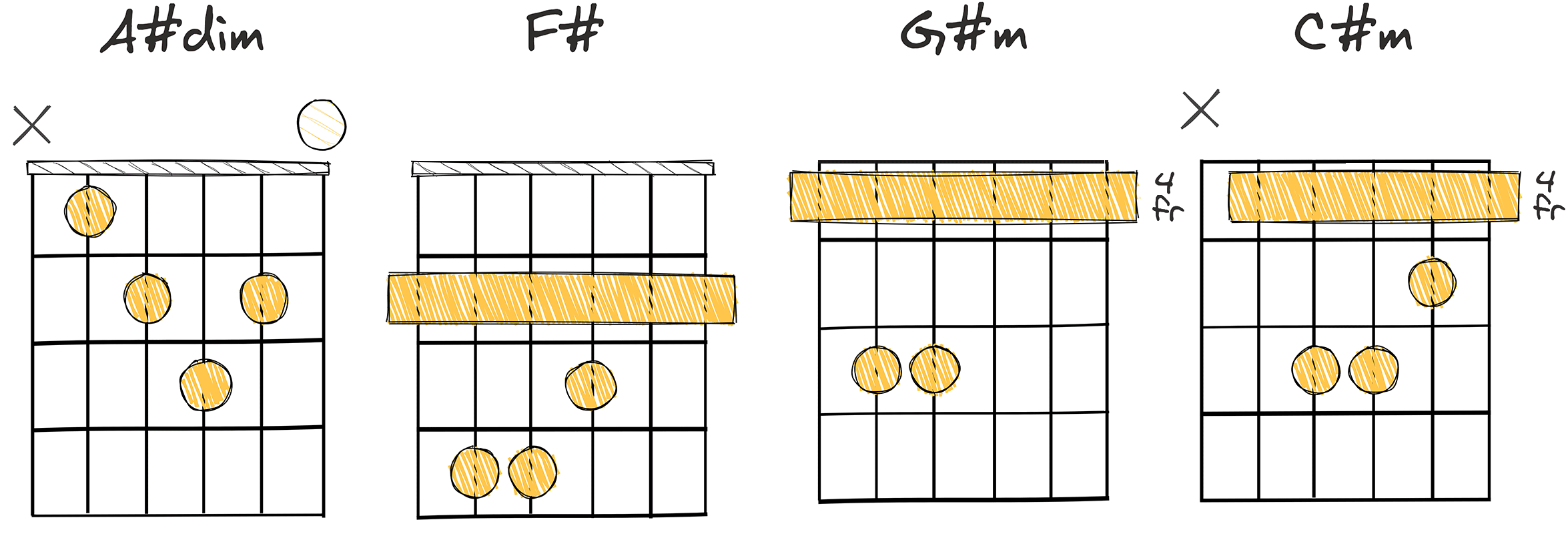
The chord progression vii°-V-vi-ii (7-5-6-2) has been a frequently recurring progression in many beloved K-Pop songs.
Historically, it has been used to express a variety of emotions, making it highly versatile and a go-to choice for K-Pop composers.
This particular progression falls under the category of Intermediate, meaning it requires a certain level of proficiency to play satisfactorily but is not overly complex.
The application of the vii°-V-vi-ii progression plays a crucial role in establishing the song’s distinctively melancholic yet hopeful ambience.
Yet, the beauty of this progression lies in its versatility; it can effectively convey a palette of emotions, from longing to love to loss, making it a favorite tool in the arsenal of K-Pop songwriters.
A look at the chords A#dim – F# – G#m – C#m (Key of B major) can lend us an understanding of how they interact within this progression.
Firstly, the A#dim chord sets a tense and intriguing stage.
A diminished chord built on the seventh degree of the B major scale creates a sensation of instability or suspense, a compelling invitation to the progression.
The F# major chord (V) follows, providing a bright and resolved shift in the progression.
It acts like a ray of sunlight breaking through the clouds, delivering a clear and robust presence contrasting the preceding tension.
Subsequently, the G#m chord (vi) adds a more complex and somber hue to the piece.
Its minor quality creates a contemplative and reflective mood, smoothly connecting the prior major chord to a deeper emotional state.
Lastly, the C#m chord (ii) reinforces this melancholic flavor, intertwining with the G#m to further enrich the emotional tapestry of the song.
It deepens the complexity, making the listener dwell in the feelings evoked by the progression.
Together, these chords take the listener on a captivating journey through various emotional landscapes, painting an engaging and profound musical picture.
While not overly difficult, the intricacy and complexity of emotions this progression can express reveals the craftsmanship and musicianship necessary to execute it effectively.
I-V-vi-iii (1-5-6-3)
A K-Pop heartbeat, crafting sentimentality within magnetic, melodic undertones.
The I-V-vi-iii chord progression is a popular sequence in K-Pop music that creates a lively and harmonious sound, often eliciting an emotional response from listeners. This progression stands out for its smooth transitions and the comfortable, predictable cadence it delivers, making it a favorite choice for many unforgettable cover songs.
- Difficulty: Intermediate
- Example: C – G – Am – Em (Key of C major)
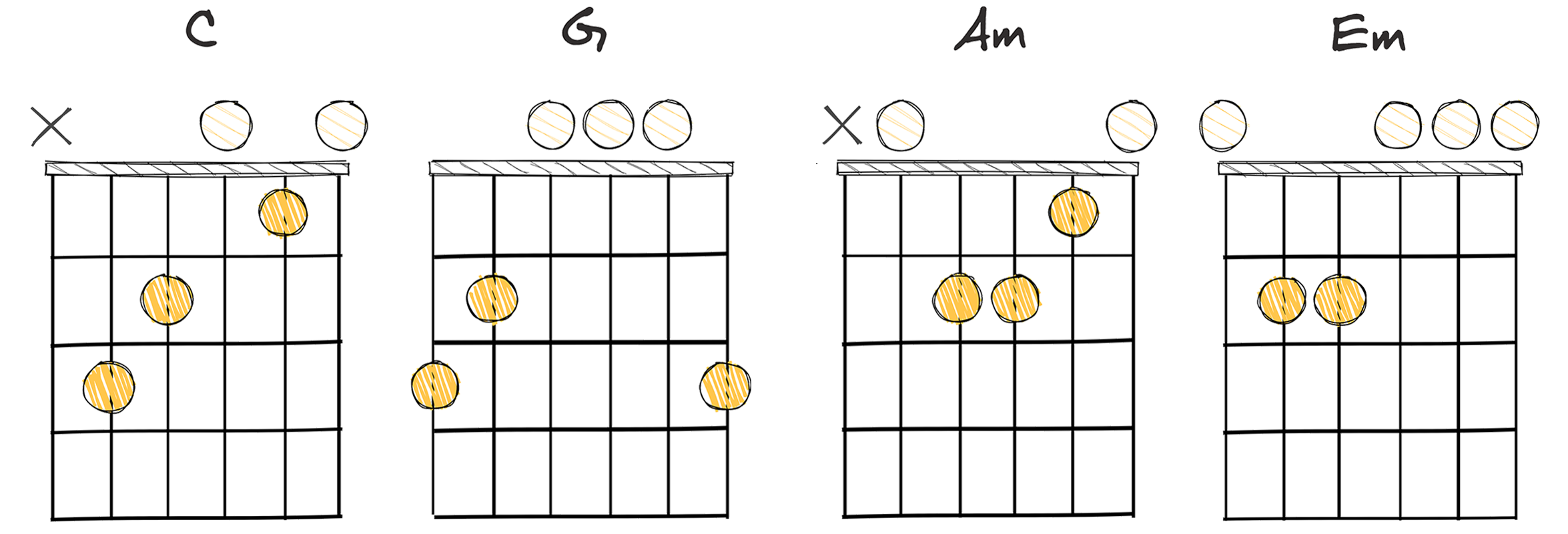
The I-V-vi-iii chord progression lends itself remarkably well for the creation of catchy and unforgettable K-Pop cover songs.
This chord progression, ranked intermediate in difficulty, aligns well with the trend of K-Pop music leaning towards intricate and complex musical composition.
The I-V-vi-iii progression, also known as the 1-5-6-3 progression in numerical representation, has a rich history in the realm of music, especially in pop music genres.
Its evolution can be traced back to the 1960s pop music scene.
This particular progression owes its popularity to the Beatles, as they often used it in their songs, contributing towards its mass appeal.
Indeed, the melancholic yet hopeful mood it induces when played resonated well with their audience which helped it to gain substantial traction in pop music.
In the realm of K-Pop music, this progression has similarly played a notable role in shaping the distinctive sound of various popular songs.
By mastering this chord progression, aspiring K-Pop musicians can unlock an impressive range of harmonic possibilities.
Not only does it open up avenues to create memorable cover songs, but it also enables musicians to inject their unique interpretation into existing K-Pop tracks.
Its intricate but melodic nature should inspire musicians to experiment and explore the myriad of possibilities this progression holds.
Understanding and implementing the I-V-vi-iii progression will undoubtedly add depth and character to their musical repertoire.
IV-I-V-vi (4-1-5-6)
A melodically addictive chord scheme bringing the signature K-Pop flavour.
The IV-I-V-vi chord progression is a simple and very popular sequence used in K-pop and various genres, offering a bittersweet and somewhat melancholic sound. It often provides a solid basis for memorable, captivating tunes especially in cover songs, creating an engaging harmony that interacts well with diverse melodies.
- Difficulty: Easy
- Example: Bb – F – C – Dm (Key of F major)
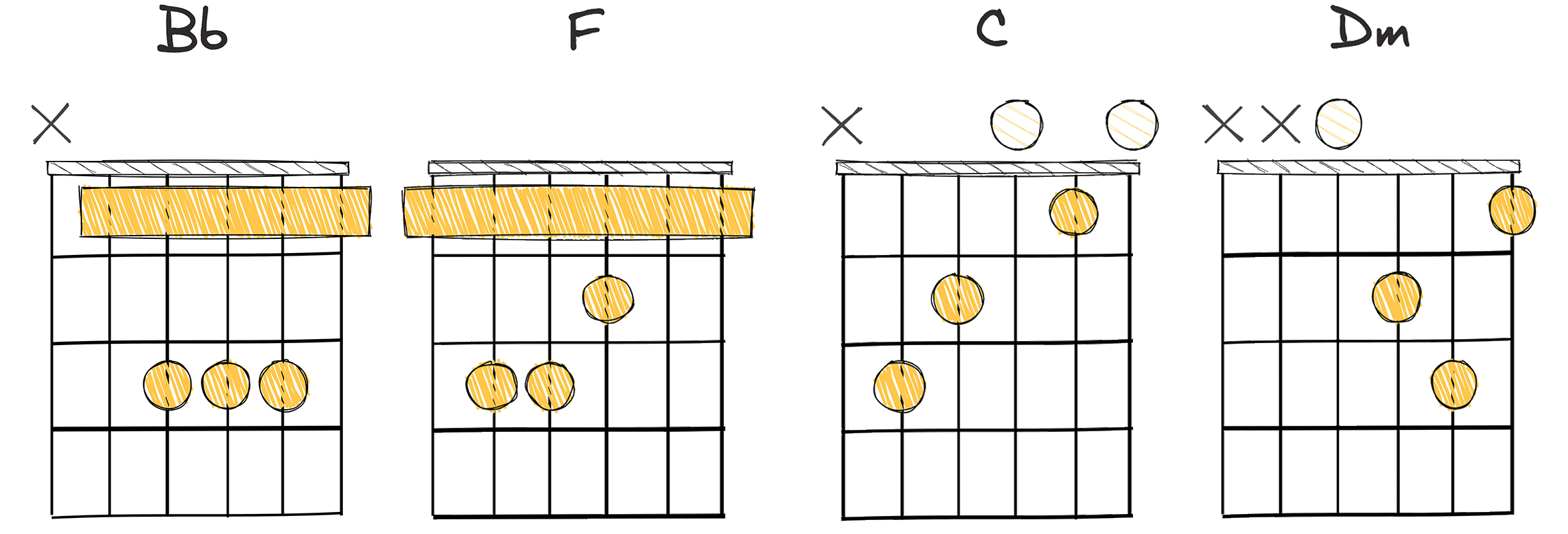
Within the realm of K-Pop music, the chord progression IV-I-V-vi (4-1-5-6) is not just a simple grouping of chords, but a compelling element that significantly contributes to the overall flavor and appeal of a song.
This progression, like all others, has a deep history within the music industry.
Going back to the earliest days of pop music, this type of progression was a cornerstone, laid by the pioneers and innovators of genre.
Its enduring popularity bears witness to its effectiveness, and to the timeless appeal of these particular chord sequences.
Over time, music trends have changed and cultural tastes have evolved, but this progression continues to be a staple in the creation of memorable pop songs.
One of the reasons for this is that the IV-I-V-vi progression is reasonably straightforward to play.
Many young musicians often start by learning this progression because it lends itself to a wide range of styles while being relatively easy to master.
Indeed, its versatility allows every musician, from beginners to professionals, to make it their own and to adapt it to their unique artistic expression.
The IV-I-V-vi progression is not just about varying the notes; it also relates to providing a balance in the song that contributes to its total appeal.
Thus, the IV-I-V-vi progression is not merely a ‘simple’ or ‘easy’ musical device; it is an essential tool that greatly contributes to the success of a song.
Despite its long history, it continues to fascinate musicians and listeners alike.
ii-I-vi-V (2-1-6-5)
A nostalgic progression bringing K-Pop’s unique melodic charm to life.
This chord progression, ii-I-vi-V, is a common sequence found in numerous K-Pop songs, yielding a nostalgic and melancholy sound. It is characterized by the transition from a minor chord (ii) to a major chord (I), followed by another major chord (VI) and back to a major chord (V), creating a melodically rich and emotionally resonant soundscape often used in K-pop music.
- Difficulty: Easy
- Example: Em – D – Bm – A (Key of D Major)
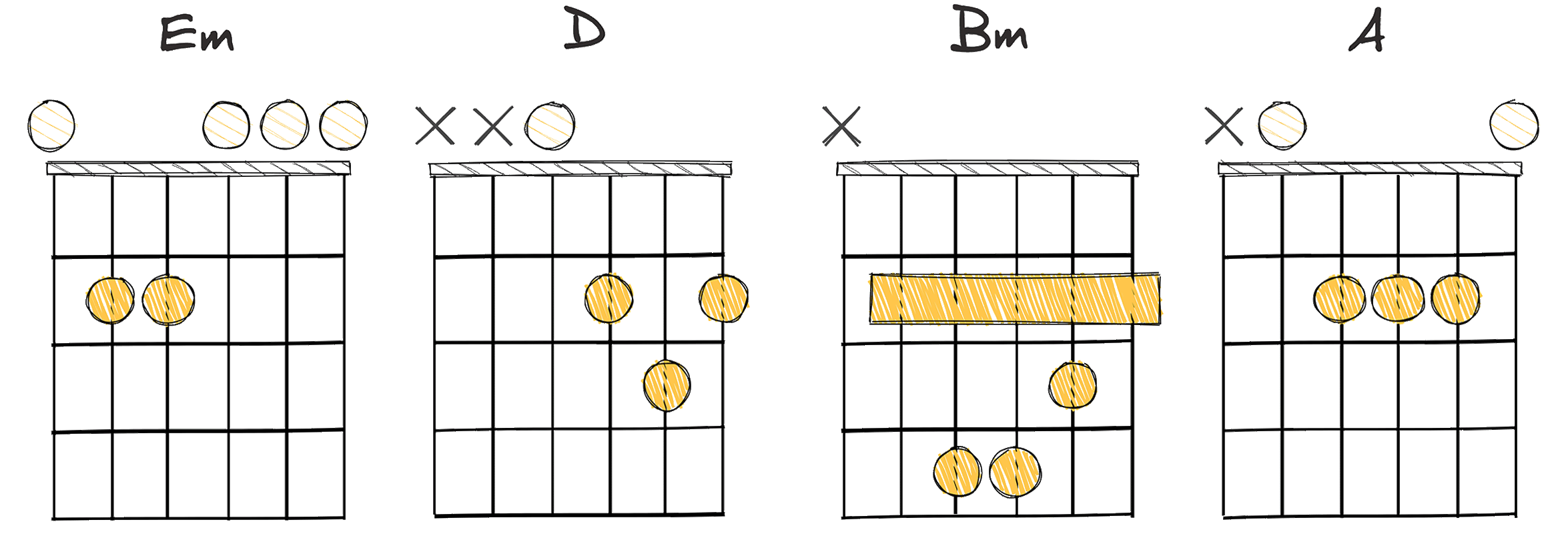
When it comes to Korean pop, or K-Pop, there is no shortage of catchy melodies and unforgettable hooks.
But, what many may not realize is the complexity and variety of chord progressions.
One chord progression commonly found in K-Pop, especially within ballads and emotional numbers, is theii-I-vi-V or 2-1-6-5 setup.
A progression like this can create a nostalgic sensation while keeping listeners on their toes due to its unique, non-standard composition.
The origins of this chord progression go well back into classical music, where composers would draw on a wide palette of chords to convey different emotions and ideas.
However, applying this chord progression in a contemporary K-Pop setting brings a fresh perspective.
This particular progression would translate into Em – D – Bm – A in the key of D major.
Despite its unconventional nature, this progression is easy to play, making it a favorite among budding musicians and cover artists.
As you look to create your unforgettable K-Pop cover song, contemplating the use of some of these non-traditional yet impactful chord progressions can be a game-changer.
Not limiting oneself to the comfort of familiar progressions can open up new realms of musical possibilities that can help distinguish your cover from the others.
Remember, effective music is not only about impressive vocals, dynamic beats, or striking visuals; chord progressions play a significant part too, forming the backbone of the compositions.
iii-vi-II-V (3-6-2-5)
A go-to K-pop progression ensuring catchy, emotional resonance.
The iii-vi-II-V (3-6-2-5) chord progression is a common chord sequence often found in K-pop ballads and dance tracks, characterized by its catchy and addictive melody line. This four-chord progression is famous for having a rich, meaningful tone that can ignite a wide range of emotions, from melancholy to joy, making it ideal for creating memorable cover songs.
- Difficulty: Intermediate
- Example: G#m – C#m – F# – B (Key of E major)
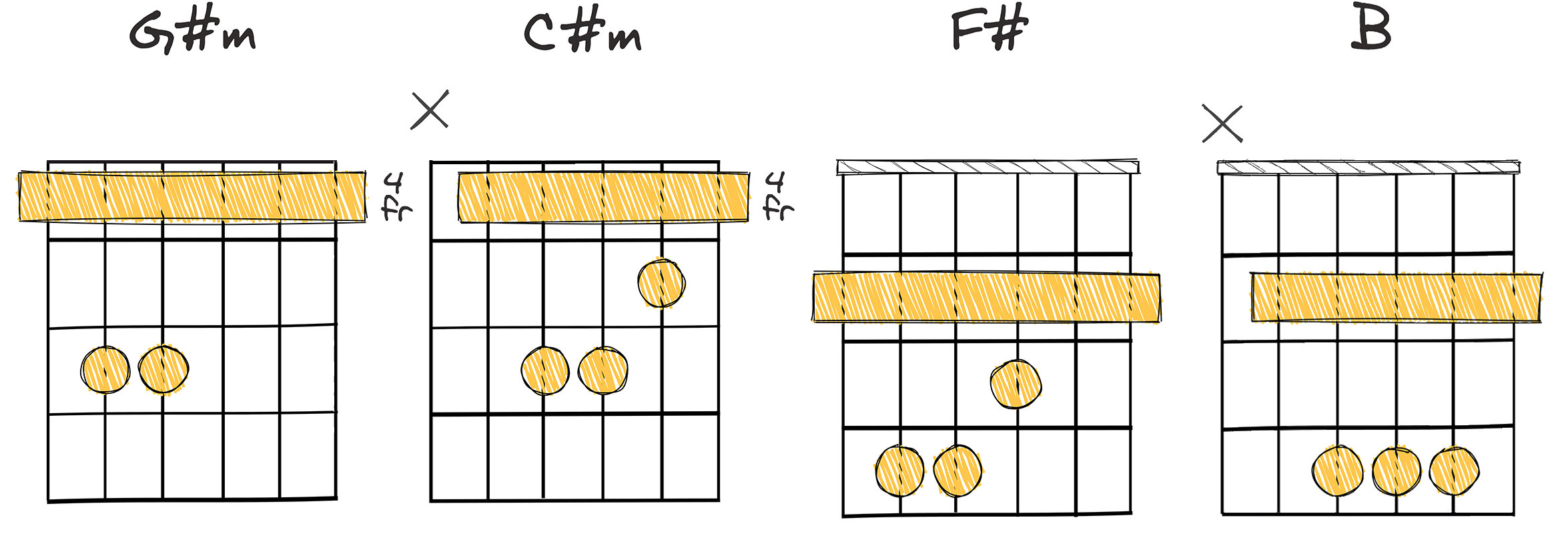
As we delve further into the intricacies of K-Pop chord progressions, we arrive at the noteworthy section nine – the iii-vi-II-V (3-6-2-5) progression.
Derived from traditional Jazz, this chord progression has found flair and appeal among K-pop idol groups and producers alike.
Its usage can be traced back to the golden era of American pop music in the 1950s and 60s.
The uniqueness of the iii-vi-II-V (3-6-2-5) progression lies in the fact that it creates a circular effect due to its repetitive cycle, which keeps the song interesting and hooks the listener.
Indeed, the circuitous nature of this progression, paired with its ambitious leaps between chords, imparts the song with a dynamic and engaging auditory experience.
This progression is often used during the chorus or bridge of a song, providing a refreshing break from the anticipated sound established earlier on.
The II chord in E major is naturally F♯ minor. If you use F♯ major in the context of E major, it’s a non-diatonic chord, meaning it’s not naturally found within the key.
Using non-diatonic chords can add interesting color and tension to a progression, but it’s essential to be aware that it’s a departure from the standard chords of the key.
Departing from the standard progressions, the iii-vi-II-V (3-6-2-5) sequence is intermediate in difficulty level.
However, mastering it translates into a wealth of rich and unique sound opportunities that can distinguish one’s music from others.
Although it may appear complex at first, with consistent practice and mastery, the iii-vi-II-V (3-6-2-5) progression becomes a potent tool for writing unforgettable K-pop songs.
Whether one is arranging a cover song or composing an original, incorporating the iii-vi-II-V (3-6-2-5) progression can result in a track that leaves a lasting impression.
Overall, the iii-vi-II-V (3-6-2-5) progression’s history, challenges, and sound qualities make it a fascinating topic in K-pop music composition.
Underlying all its alluring complexities, it’s an indispensable chord progression that K-pop musicians should consider for their next memorable piece.
iii-VI-IV-I (3-6-4-1)
This progression provides an authentic K-pop vibe for a unique twist.
This iii-VI-IV-I (3-6-4-1) chord progression is common in K-Pop music and can give a melancholic but hopeful tone to your song. It is a popular choice for creating emotional depth and tonal variety, making it ideal for cover songs that aim to leave a lasting impression.
- Difficulty: Intermediate
- Example: Em – A – C – G (Key of G major)
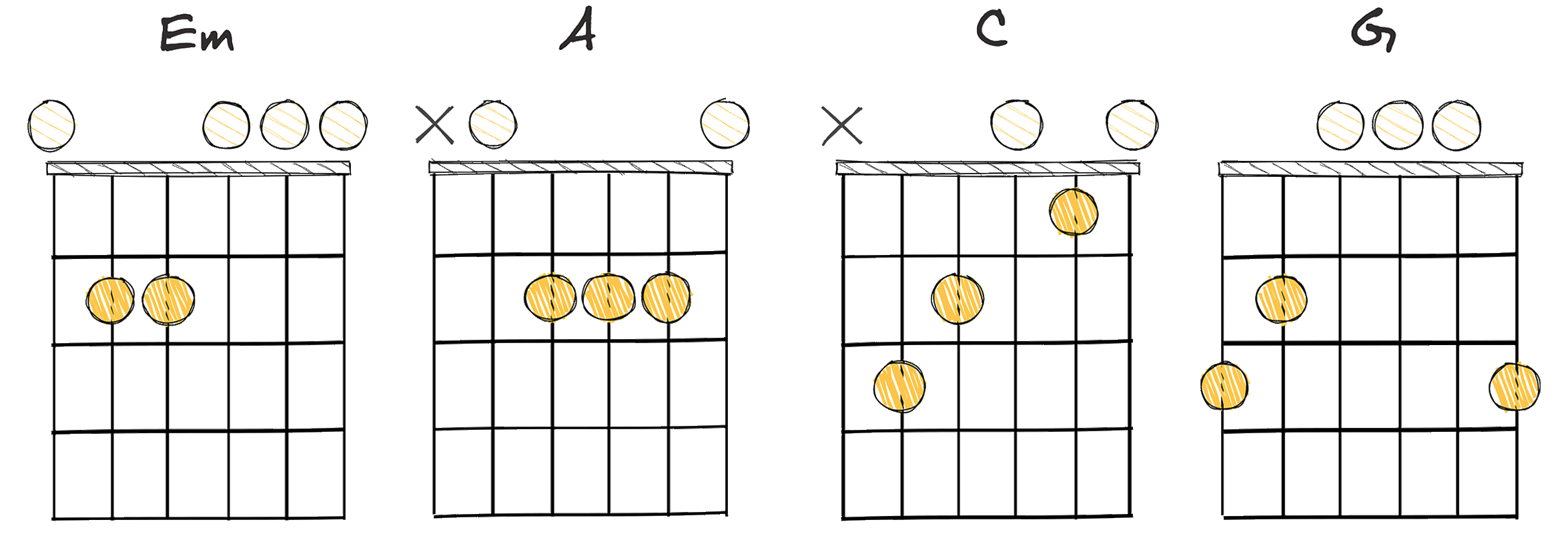
The world of K-Pop is vibrant and diverse, much like the music it produces.
Central to creating the infectious tunes K-Pop is known for are skillfully crafted chord progressions.
In the vast realm of K-Pop music, the iii-VI-IV-I chord progression (3-6-4-1) holds a special place, paired with unforgettable melodies capable of resonating with audiences worldwide.
Notably, the iii-VI-IV-I progression is on an intermediate level of play, making it complex enough to capture a listener’s interest yet accessible to a wide range of musicians.
This chord progression’s charm lies in this balanced intricacy.
It’s not necessarily straightforward nor excessively complicated, giving way to a multitude of creative possibilities.
The iii-VI-IV-I progression’s legacy in K-Pop mirrors its broader influence in contemporary music.
Its capacity to shape the sound of a piece while maintaining a sense of familiarity makes it a popular choice among K-Pop musicians and producers.
Often, emphasis is placed on the latter two chords, the IV and I, which gives melodic momentum to the song without disrupting its overall mood.
Shifting our focus to a different musical combination, the Em – A – C – G chords in the key of G major also exhibits the fluid and evocative nature of K-Pop chord progressions.
These chords, although simpler, can form an incredibly catchy tune with the right melody and rhythm, just as with the iii-VI-IV-I progression.
The goal should always be to bring out the best in your cover song through well-designed K-Pop chord progressions.
In doing so, you celebrate the depth and diversity of K-Pop music.
vi-II-V-I (6-2-5-1)
An iconic chord progression, adding exotic inflections to your song.
The vi-II-V-I (6-2-5-1) chord progression is a popular structure in K-pop music, capable of producing a majestic and unforgettable melody. This chord progression, with its emphasis on the sixth, second, fifth, and first notes in the scale, can be used to create unique and captivating cover songs.
- Difficulty: Intermediate
- Example: Am – D – G – C (Key of C major)
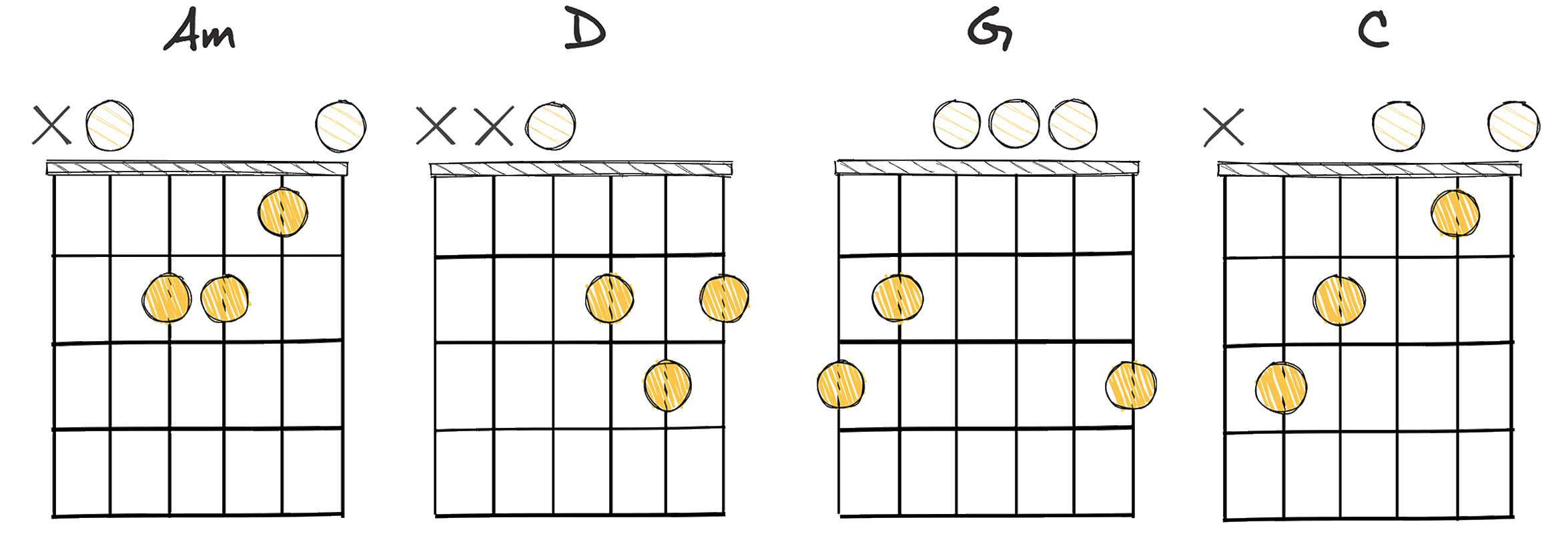
The vi-II-V-I (6-2-5-1) chord progression is one of the many fascinating chord progressions commonly found in K-Pop music.
It is an eye-opener into the dynamic versatility of K-pop composition and arrangement.
Regarded as an intermediate progression, it requires a firm understanding of the musicianship to play it effectively.
However, once masterfully utilized, it lends a catchy trajectory to a song, engaging the listener in an unforgettable melody.
Delving into its roots, the 6-2-5-1 progression has its origins entrenched in the golden era of jazz, feeding into the mainstream music of the 20th century.
Its adoption by K-Pop producers demonstrates the willingness to incorporate diverse musical elements into their work.
Let’s unpack this in musical terms.
Translating the Roman numerals into key of C Major chords, we get Am – D – G – C.
The musical journey laid out by the 6-2-5-1 progression is vital in igniting songs’ emotional textures.
Each chord carries a distinct sentiment, channeled effectively to the listeners through astute compositional stridency.
It is compelling evidence of the genre’s deft incorporation of complex and time-tested musical elements, solidifying its standing on the global musical stage.
Moreover, this progression’s versatility is not only confined to the realms of K-Pop but also extends to other genres catering to varied musical tastes.
Thus, amplifying its universality and testament to its enduring appeal.
I-iii-IV-V (1-3-4-5)
A vibrant K-Pop progression exuding both charm and sentimental touch.
This chord progression, I-iii-IV-V (1-3-4-5), delivers a distinctive sound often found in catchy tunes of K-pop music, weaving together elements of brightness and surprise. It offers a fresh, unconventional tonal shift that is both evocative and memorable, making it ideal for creating engaging cover songs.
- Difficulty: Intermediate
- Example: G – Bm – C – D (Key of G major)
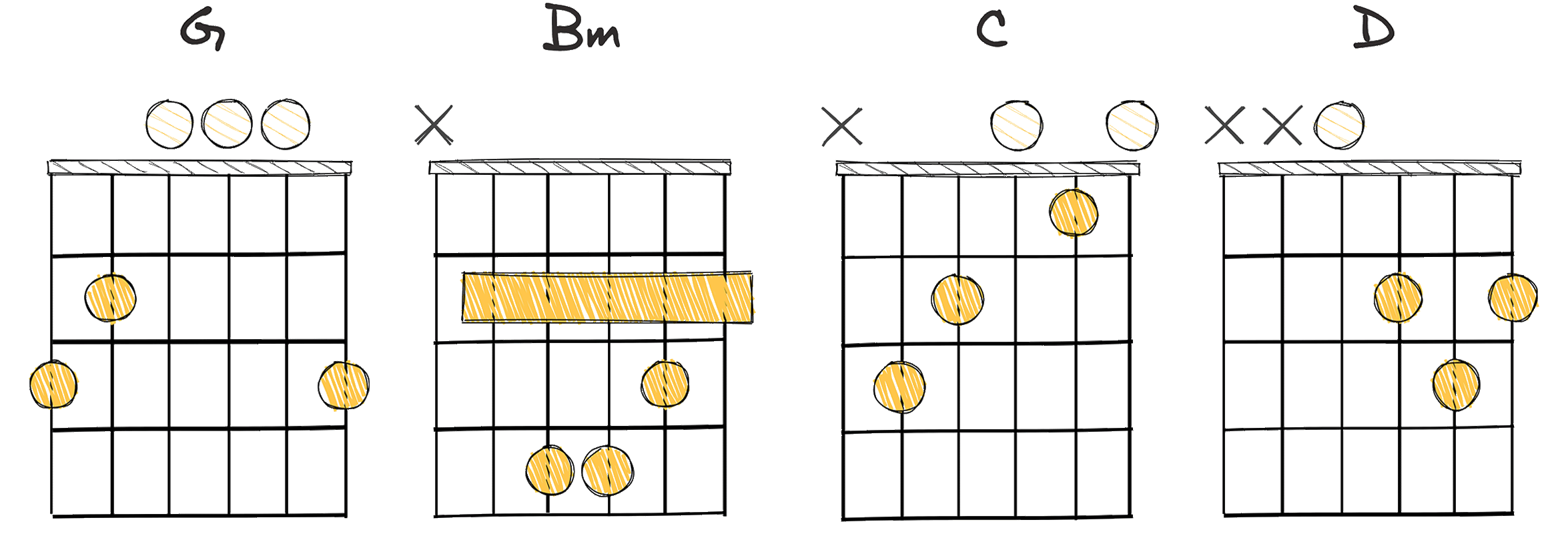
In our study of K-Pop chord progressions for creating an unforgettable cover song, one that stands out prominently is the I-iii-IV-V (1-3-4-5) progression.
This progression, often found in K-Pop music, exudes a poignant mix of hopefulness and melancholy.
What makes it particularly unique is how it combines major and minor chords to infuse the melody with a depth of emotion.
Rooted in the structure of these chords is the capacity to tell a compelling story set to music.
The I-iii-IV-V (1-3-4-5) progression is an intermediate chord progression to play, yet its execution brings a fresh spin to K-Pop songs, fueling their global popularity.
The G – Bm – C – D (Key of G major) chord progression is a spot-on instance of this.
Mastery over this progression opens up immense possibilities to infuse your cover song with an authentic K-Pop flavor.
While the I-iii-IV-V (1-3-4-5) progression might not be the most common one, it surely adds an unexpected twist to the rhythm, catching the listener off guard.
Romantic ballads, in particular, leverage this progression to weave a sense of longing and introspection into the melody.
Studying this progression can certainly elevate your understanding of K-Pop music’s structure.
This knowledge can help you achieve an authentic sound in your next cover song.
Additionally, experimenting with this progression can push your musical boundaries and grow your skills as an artist.
Therefore, as an aspiring cover artist looking to make your mark in the K-Pop domain, mastering this chord progression could be your first step to leaving an unforgettable imprint in this genre.
With continuous practice and creativity, the I-iii-IV-V (1-3-4-5) progression could breathe new life into your K-Pop covers.
IV-V-vi-I (4-5-6-1)
This K-Pop progression lends a captivating, emotive twist.
This IV-V-vi-I chord progression, commonly used in K-pop music, creates a pleasing resolution to the listener’s ear as it circularly leads back to the original ‘home’ chord. Known for its melodic and emotional resonance, it is a versatile choice that can be used to create unforgettable cover songs across a range of moods and styles.
- Difficulty: Easy
- Example: Bb – C – Dm – F (Key of F major)
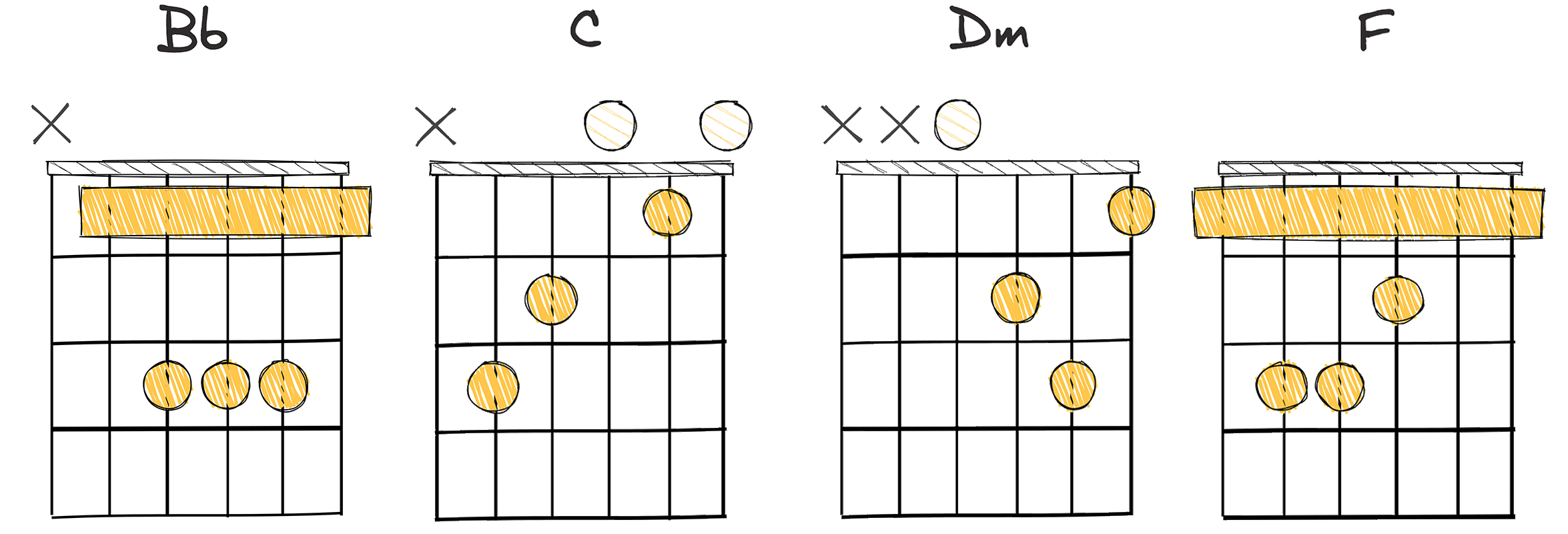
The K-POP chord progressions for your next unforgettable cover song can range widely, each offering its unique sound and emotion.
But one progression stands out for its simplistic beauty and rich emotional depth, the IV-V-vi-I (4-5-6-1) progression.
The IV-V-vi-I chord progression has been extensively utilized in many genres but stands strong in the vast array of K-POP ballads and upbeat dance numbers.
It offers an engaging balance of tension and resolution, mainly when used in pop ballads, creating an emotionally resonant soundscape that K-POP is appreciated for.
Assuming that the progression was in F major, the chords would be Bb – C – Dm – F.
This simplicity facilitates songwriting and performance, making it an efficient tool for budding musicians and established artists.
It’s crucial to remember that while the IV-V-vi-I progression is easy to play, it does not lose its musical depth.
This progression’s distinctive texture comes from the amalgamation of the major and minor chords, contributing to K-POP’s diverse musical spectrum.
Utilization of this progression demonstrates how an easy-to-play progression can be transformed into a highly complex musical masterpiece with the right creative approach.
Despite its apparent simplicity, the IV-V-vi-I progression has a rich history, tracing back to Classical music.
Over the centuries, this progression has evolved and adapted, making its way into every aspect of the modern music scene, including K-POP.
It’s fascinating to witness how a chord progression, which initially was used in Classical composer’s creations, can still be relevant today, especially in a genre as dynamic and experimental as K-POP.
An integral aspect of K-POP’s global appeal is its propensity to borrow and adapt from various genres, making it wonderfully diverse.
The presence of such universal chord progressions like IV-V-vi-I significantly contributes to this versatility.
IV-I-ii-V (4-1-2-5)
An iconic progression, encapsulating K-Pop’s blend of nostalgic and dynamic sounds.
The IV-I-ii-V chord progression creates a deeply resonant sound that is often found in the emotive ballads and upbeat anthems of K-pop music. This certain progression moves between chords smoothly, producing a compelling melodic line which entices and captivates listeners.
- Difficulty: Intermediate
- Example: A – E – F#m – B (Key of E major)
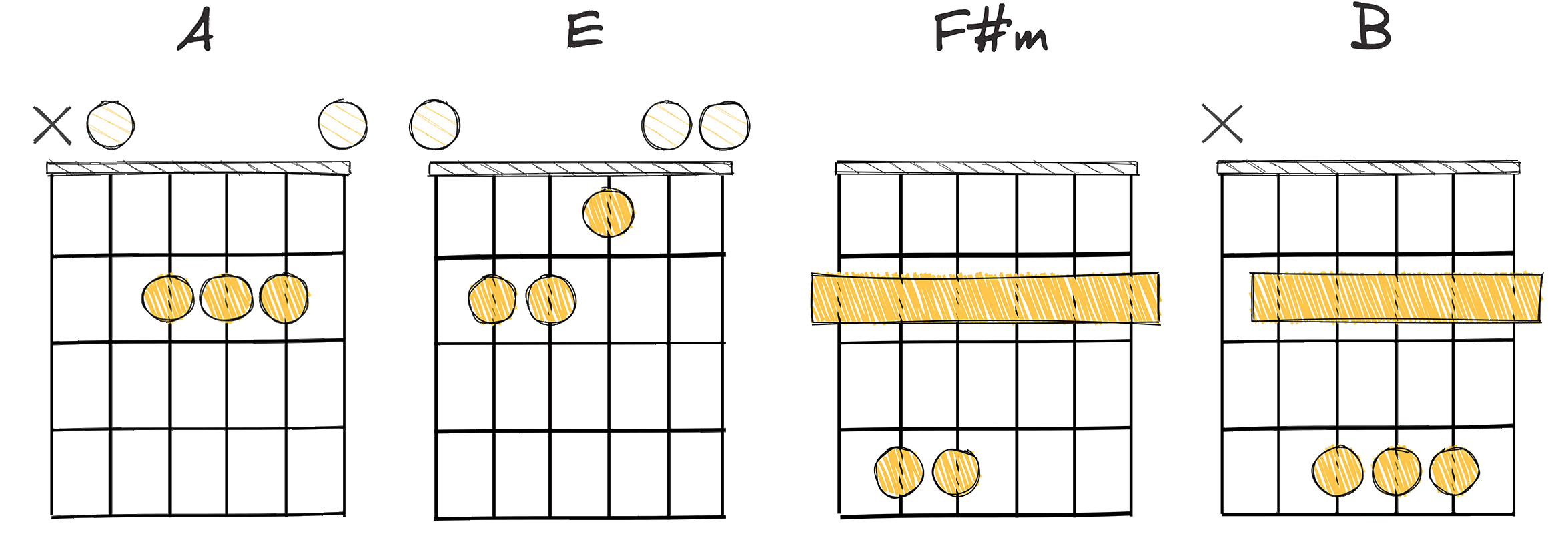
Chord progression IV-I-ii-V (4-1-2-5) is a key structural element in K-Pop and many renowned songs, including “I’m Your Girl” by S.E.S., are based on this progression.
The chord progression of IV-I-ii-V (4-1-2-5) has a rich history, being utilized in various genres of music ranging from classical pieces to modern pop songs.
The use of this progression in K-Pop music, in particular, blends the traditional with the contemporary, inheriting the beauty of classic music theory while ensuring relevance for a modern audience.
Chord IV-I-ii-V (4-1-2-5) provides a smooth transition between different parts of a song, granting the composition an overall sense of harmony and balance.
This chord progression creates a sense of resolution and completion, eliciting complex emotional responses from listeners and significantly enhancing their overall song-listening experience.
K-Pop constructs melodies and harmonies using these chords to develop a distinctive sound.
When handled with care, IV-I-ii-V (4-1-2-5) can breathe life into a song, driving the melodic and rhythmic dynamics while also shaping the mood and atmosphere.
This progression, while intermediate to play, offers a great deal of malleability and adaptable tonality for a wide variety of songs.
Therefore, understanding this chord progression grants musicians the ability to leverage it effectively for conveying varied emotional nuances through their music.
K-Pop artists often rely on well-grounded understanding of this and other chord progressions to craft their unforgettable and highly appealing pop anthems.
ii-I-IV-V (2-1-4-5)
This progression adds a captivating twist, enriching your K-Pop cover melody.
This ii-I-IV-V (2-1-4-5) chord progression is a popular sequence in K-Pop music, characterized by its smooth transitions and build-up. It starts off on a suspenseful note with the seventh degree, resolves to the tonic for stability, moves to the fourth for a little vibrancy, and ends on the fifth for a perfect cadence, creating an enchantingly catchy musical theme.
- Difficulty: Intermediate
- Example: F#m – E – A – B (Key of E major)
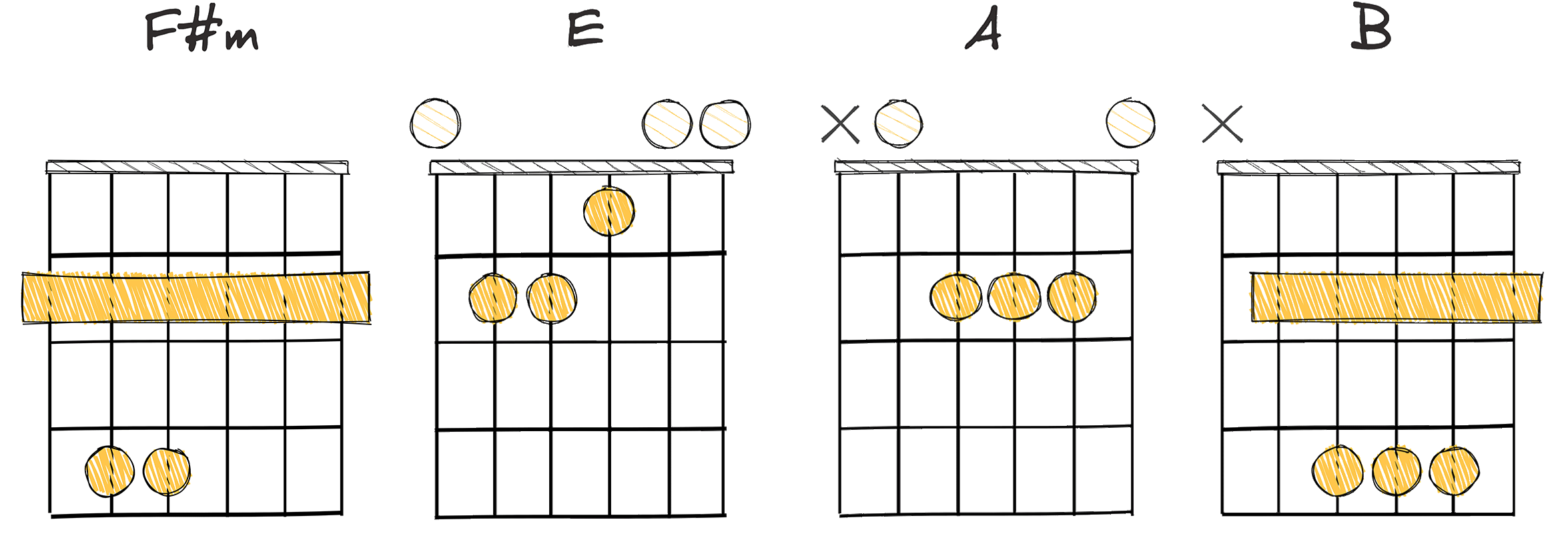
One of the most recognized chord progressions in K-Pop is the ii-I-IV-V (2-1-4-5).
This sequence of notes can be found in many popular K-pop songs, and offers a unique blend of upbeat and sorrowful undertones, making it a beloved progression among K-pop artists.
Interestingly, this chord progression is not entirely native to K-pop.
Its roots can be traced back to the classical music era, where it was commonly used in various symphonies and sonatas.
The ii-I-IV-V progression’s ability to convey a wide range of emotions, extending from melancholy to joy, is likely the reason for its enduring popularity in music.
Despite the seeming complexity of this progression, it is relatively intermediate to play, particularly for those with a fundamental understanding of music theory and chord structures.
Essentially, this chord progression consists of a second (ii) chord, followed by the tonic or root note (I), the fourth (IV), and finally the fifth (V).
The transition between these chords offers a satisfying sonic journey, keeping the listeners hooked.
The ii-I-IV-V chord progression offers a musical journey that appeals to listeners of many genres, and has been embraced not only by K-pop artists but also by musicians globally, reinforcing its status as a go-to sequence in songwriting.
Indeed, this progression’s reach extends beyond K-pop and Western music.
It has been utilized in various musical styles worldwide, demonstrating its universal appeal.
The global popularity of this chord progression also speaks to its versatile nature, which allows it to be adapted to various genres and musical styles, thus creating unique and genre-defining sounds.
To help visualize this chord progression in action, we can use the chords F#m – E – A – B in the Key of E major as an example.
When played in succession, these notes create a beautiful harmony that can captivate the listener’s ears.
Even within the diversity of K-pop music, the ii-I-IV-V progression emerges as a constant.
Its compatibility with varied musical elements in K-pop songs – from the intense, synchronized choreographies to the flamboyant music videos – further proves its applicability and timelessness in the K-pop genre.
Above all, the ii-I-IV-V progression serves as a testament to the rich musical diversity within the world of K-pop.
Despite the genre’s fast-paced evolution, the presence of classical chord progressions reveals a nod to its musical roots and the unchanging beauty of music theory, whether it is in K-pop or any other type of music.
The Bottom Line
Overall, these various chord progressions provide an extensive list of options for musical compositions.
They form the backbone of many classic and contemporary songs in multiple genres of music, offering a mixture of fundamental and intricate harmonies.
Exploring these progression patterns enables musicians to enhance their creativity, deliver an emotional impact, and maintain listener interest.
The flexibility of these chord progressions confirms the countless possibilities for melodic invention, thus showing the infinite creative potential within the domain of music.
In love with guitars, and gear; expert in all things music! Been writing about guitars for about 5 years and counting. Born in the ’90s. Alma Mater: University of Havana. Always curious, trying to understand the world. #TeamFender




